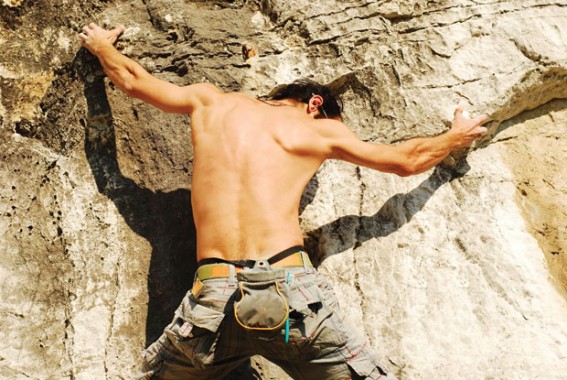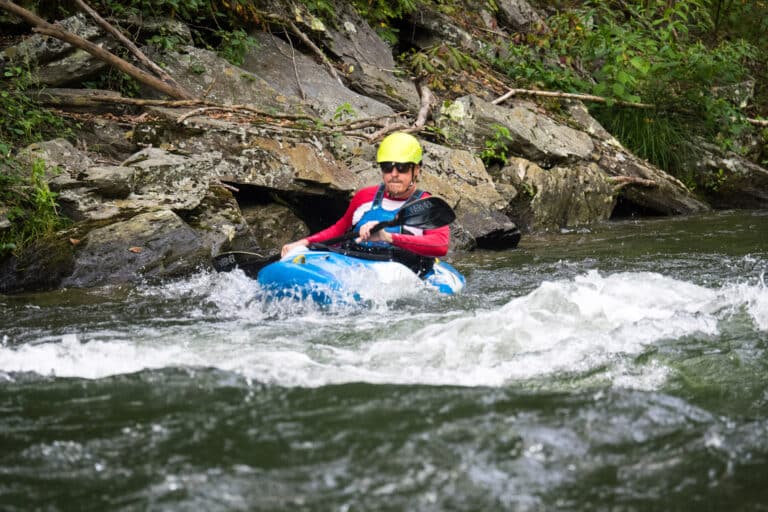A rookie rock climber lets it all hang out.
Little known fact: there are more plastic flamingos in the world than real ones. It’s a sad reflection of our willingness to sacrifice artificial habitats for real ones. We cut down trees and name streets after them.
Similarly, we trade the outdoor experience for the climate-controlled safety of the great indoors. I’m not knocking gyms. I regularly swim and climb there. And I once spent 18 consecutive hours at the YMCA taking every class offered, from water aerobics to belly dancing.
But too often I resort to the quick convenience of a gym workout instead of experiencing the rainy, windy, muddy, real world beneath my feet. Indoors, I was burning the requisite calories, but I was missing the connection.
I realized this recently when I joined my climbing buddy on the rock. I had been climbing at a local gym for a while, which provided a great workout full of adrenaline and intensity. But there was something far more powerful about scraping my shins against real granite covered in spider webs and bat dung.
We stood on a carpet of crushed pine needles and listened to the river. The bluff before us was pockmarked with flakes and finger holds that were just as challenging as any mountain climb. But we weren’t in the mountains. We were inside the Atlanta perimeter, climbing a bouldery bluff along the Chattahoochee River.
Mike went first. He glided gracefully up the granite, swinging and pirouetting across the vein-popping vertical. It was a boulder ballet: the dancer lost himself completely in the dance. Athleticism became art. He rappelled back down to Earth, purified, and handed me the chalk bag.
I didn’t have any of Mike’s fluid finesse. I awkwardly pulled myself up the first rock ledges, digging my fingernails into a crack of rock, then fell back down.
“You look like a white boy on the dance floor—all arms and no legs,” Mike laughed. “Use your whole body.”
I climbed clumsily back onto the boulder. This time, I kicked my right heel over my head and into the rock, and, like a lever, it lifted my body over the boulder. Mike whooped and whistled below.
Finger-cramped and jelly-armed, I picked my way along a diagonal crimp in the rock. When I couldn’t find a fingerhold, I smeared the rubber soles of the shoes against the boulder. It gave me just enough grip to get me onto the overhanging bluff brow. Halfway up, I braced myself against the rock ledge and looked out across the treetops. I could see the river—a brown squiggly line with willow and birch bending over its banks. The morning sun slowly melted mist off the water. A heron winged across the river and perched on a mossy rock.
I reached the next ledge, and the river roared its applause. But the last move was the hardest, and I’d need every scrap of strength I had left. So I stalled for a few more minutes atop the rock ledge, soaking in the scenery: the tinge of autumn in the trees, the hawks spiraling over the water, the wind high in the pines. I admired the ancient cracks of the rock face, like lines of a primordial palm, holding me steady.
This was why I climbed. This was why I loved to move my body. Contact! Contact! said Thoreau. For me, contact with the gritty granite and solid earth strengthened more than my body.
I chalked my hands—bloody and blistered from the rock—and shook my arms loose. After a few false starts, I dangled out along the overhanging flake of rock, fingers pinched around the thin crack, legs flailing beneath me. I panted hard and purse-lipped, like a weightlifter on his last rep of bench press.
“Breathe, baby! You’ve gotta get O-2!” Mike shouted below.
A golf ball of granite jutted out from the boulder above me. All I had to do was reach it and pull myself up. My arms were shaking; my teeth were clenched. I was in fourth grade P.E. class again, hanging from a chin-up bar.
“Hold on! One quick, explosive burst and you’ve got it!” Mike yelled.
My fingers started to slip. But I was an arm’s length away from the golf-ball rock. All it took is one more move, one last gutsy grunt to the top. In the distance, I could hear the river’s water dance over smooth, time-worn boulders. I took a deep breath, let go of my grip, and lunged for the rock. •








